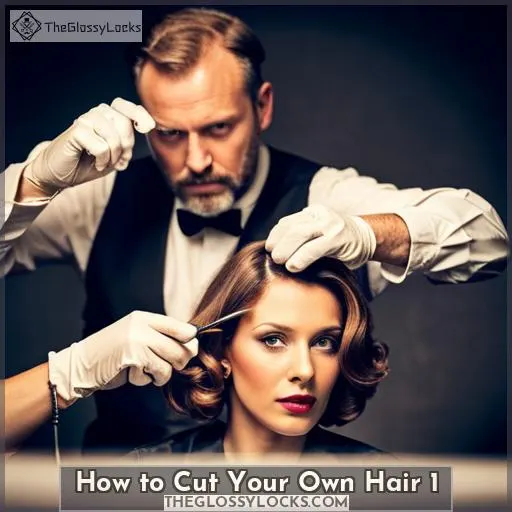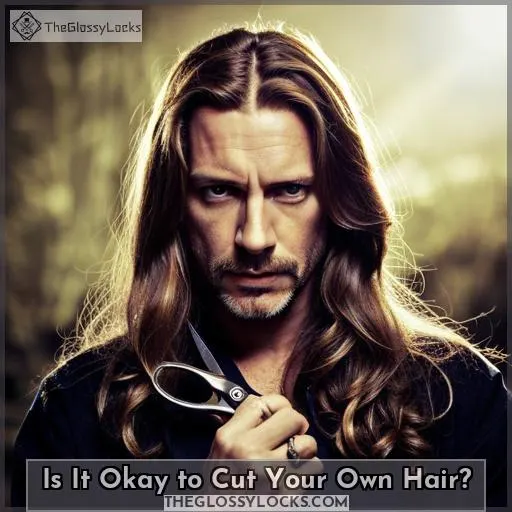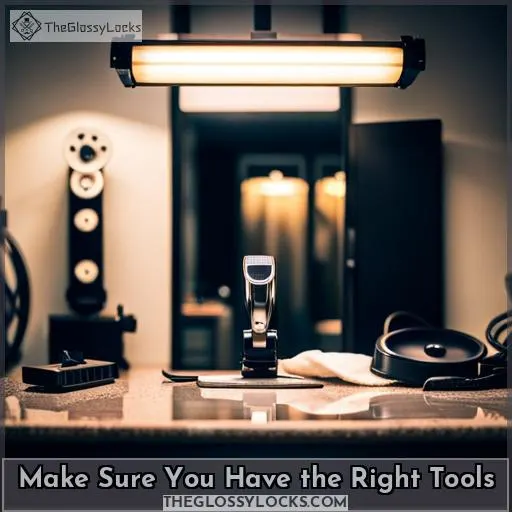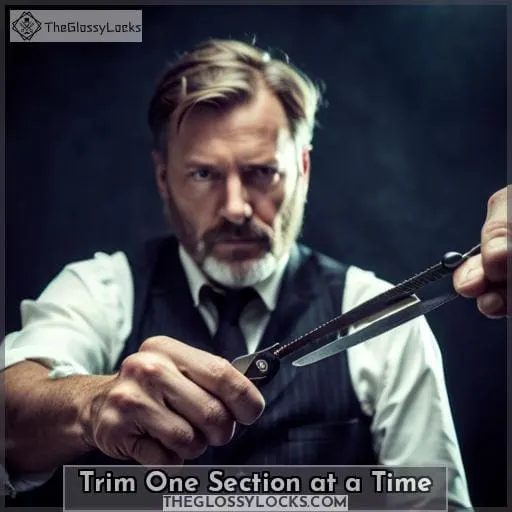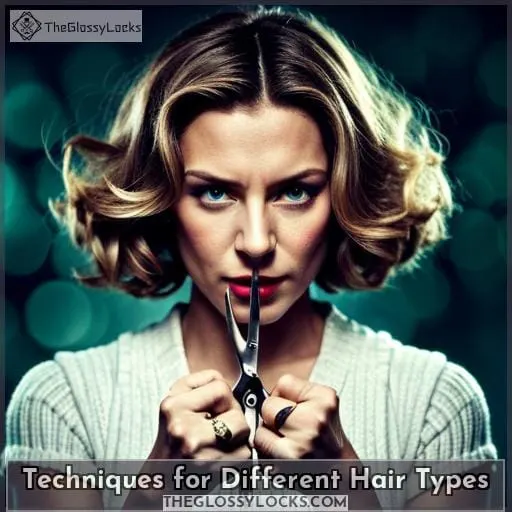This site is supported by our readers. We may earn a commission, at no cost to you, if you purchase through links.

It’s estimated that over 35 million Americans are cutting their own hair at home in 2023.
With so many of us taking our styling into our own hands, it can be daunting to know the best way to go about it.
But don’t worry – you have access to some expert tips and tricks right here!
In this article, we’ll teach you how to cut your own hair like a pro from the comfort of your home.
We’ll cover what tools you need, techniques for different types of hair, and essential maintenance for keeping healthy locks between salon visits.
So if you’re ready to take matters into your own hands, let’s get started!
Table Of Contents
- Key Takeaways
- Meet the Experts
- Is It Okay to Cut Your Own Hair?
- Make Sure You Have the Right Tools
- Wet or Dry: Which is Better for Trimming?
- Finding the Perfect Tutorial
- Sectioning Your Hair for a Successful Cut
- Trim One Section at a Time
- Techniques for Different Hair Types
- Maintaining Hair Health Between Salon Visits
- Tips for DIY Bang Trims
- Frequently Asked Questions (FAQs)
- Conclusion
Key Takeaways
- Seek advice from professional stylists or expert tutorials for successful DIY haircuts.
- Use the right tools, such as high-quality scissors and combs, for a successful DIY haircut.
- Section your hair correctly and focus on one section at a time for a precise cut.
- Different haircuts require different techniques and tools.
Meet the Experts
To get the best results when cutting your hair at home, it’s important to seek advice from a professional stylist or expert tutorial. Haircutting techniques vary depending on experience level and type of hair, so understanding the basics is essential for success.
DIY tips can help you master basic cuts such as the bob or pixie cut. Learning more advanced styles like layered, angled, and V-shaped cuts require practice with an experienced mentor.
It’s also important to maintain healthy hair between salon visits by using serums and oils, as well as avoiding harsh chemicals that may damage your tresses over time.
Having access to tutorials created by experts can be incredibly helpful in mastering different cutting techniques for various types of locks, including curly ones which need special attention when wet or curl-by-curl dry trimming split ends.
On straightened manes, it requires releasing tension first in order to preserve natural length without any drastic changes occurring during the styling process.
Additionally, having the right tools is essential – high-quality shears, scissors, double-edged combs, no-slip clips, etc. These items will make sure all lines are clean, neat, even, and sections correctly separated.
In addition, bang trims are a great way to keep those pesky fringe hairs looking fresh between full haircuts.
Finally, remember that if you ever feel unsure about how to tackle a certain haircut, always consult a professional. They have the training, skills, knowledge, and geometric vision needed to create the perfect look for each individual client.
Is It Okay to Cut Your Own Hair?
The decision to cut your own hair can be a difficult one. After all, it’s not only a matter of style and personal preference but also of skill level and knowledge.
- Get expert advice. Seek out tutorials from professional stylists or experts who have years or even decades worth of experience cutting different types and textures of hair.
- Have the right tools. Investing in quality scissors, combs, clips, etc., will make sure all lines are cleanly done with sections properly separated.
- Take care between salon visits. Use serums, oils, deep conditioners to protect against split ends and other forms of damaging effects while still enjoying some styling freedom.
Ultimately, though, whether it’s safe for you personally to cut your own hair depends on several factors.
Make Sure You Have the Right Tools
Having the right tools is essential to ensure a successful DIY haircut. Invest in high-quality hair scissors, combs, and clips for the best results. Choosing the proper selection of these items will provide quality assurance that cutting techniques are done safely and accurately.
A great alternative to salon visits, having the necessary supplies on hand can make all the difference between an expertly cut style or one needing repair by a professional stylist.
For starters, investing in good shears makes trimming much easier as it prevents tugging of locks while providing accurate detail work around edges or layers that need special attention. Double-edged combs come in varying sizes for sectioning off areas during cutting, which helps keep track when snipping off split ends from wet or dry strands.
Finally, don’t forget about flat irons with tourmaline ceramic plates featuring adjustable heat settings up to 455°F, so you can achieve perfect sleek styles without damaging your crowning glory over time! With such helpful tools combined with tutorial videos available online by experienced professionals who know what works best according to each individual’s unique needs, there truly is nothing stopping anyone from becoming their own hairstylist today!
Wet or Dry: Which is Better for Trimming?
Deciding between wet or dry hair for trimming can make a world of difference in achieving the desired haircut. For starters, when it comes to dry styling, understanding the common causes of split ends, such as environmental stress, is crucial as cutting too much could cause split ends and an uneven look that’s hard to fix without professional help.
Generally speaking, if you’re looking for subtle changes like reducing bulkiness on the sides or just tidying up your layers, then dry cutting will work best due to its accuracy.
On the other hand, if you have long locks and need more than a few snips here and there, then wetting your mane may be necessary. This method encourages uniformity while helping keep tresses healthy by preventing breakage from any excess tension created during cutting techniques.
You’ll also find many DIY tutorials online detailing specific haircuts such as bobs or pixie cuts, so even novice stylists can follow along at home!
But no matter what type of style you choose, always remember: start small because mistakes are easily made but not always reversible without expert assistance. So take extra precautions before plunging into something drastic, especially when it comes down to chopping away large chunks of hair all at once.
Taking these tips into consideration will go far in ensuring success, regardless of whether one opts for using scissors on either dampened strands or opting out completely from moistening their mane beforehand.
Finding the Perfect Tutorial
Finding the perfect tutorial for your haircut can be a challenge, so researching tutorials created by hair experts or stylists is essential for achieving the desired look. According to research, 94% of people report satisfaction with their DIY haircuts when using expert-created tutorials.
- Buy high-quality tools – Invest in a pair of professional shears that will not only give you precision cuts but also protect against split ends or other damage caused by dull blades. Double-edged combs and no-slip clips can help keep sections separated while trimming.
- Utilize online resources – With an abundance of video tutorials available at any given time, it’s easy to find step-by-step instructions suited specifically for each type of hairstyle you want to create! But remember—don’t just follow any random advice; make sure they come from reliable sources like certified professionals who have extensive knowledge in this field.
- Take small steps – Trimming too much at once could lead to disastrous results such as uneven lines and lopsided layers – something that may require more than just scissors and combing skills! To avoid these costly mistakes, start small with short snips instead of taking off large chunks all at once – even if it takes longer than expected! Taking cautionary measures such as these will ensure successful outcomes every time without having to worry about making irreversible errors due to bad decisions made during styling sessions alone.
Sectioning Your Hair for a Successful Cut
Sectioning your hair correctly is key to creating the perfect haircut at home, so arm yourself with double-edged combs and no-slip clips for best results.
Strategically sectioning your hair can make a big difference in achieving accurate cuts. The most important part of cutting any hairstyle is making sure you’re working on one layer or section at a time.
For bob cuts, start by dividing the back into two sections horizontally before separating each side vertically into three parts. If you’re going for curls, divide each curl individually using thin sections. Release tension as needed to get an even cut throughout all areas of natural length.
When trimming split ends or dry trimming layers such as angled haircuts, use smaller comb teeth and make sure to approach it slowly.
Following these tips will guarantee success when attempting DIY haircuts that require precision styling techniques like those found in professional salons today!
Trim One Section at a Time
Take your time and focus on one section of hair at a time to get the perfect cut! Don’t rush it or you may end up making trimming mistakes. Work with small sections using no-slip clips and double-edged combs for more precise results.
When cutting, release tension from each curl as needed so that natural length is evenly distributed throughout all areas of the hairstyle.
For bangs, use DIY trims between salon visits instead of relying solely on professional haircuts – this will save money while maintaining freshness without losing the desired shape or style.
Finally, make sure to choose tutorials created by experts when learning how to cut different styles – their advice is invaluable when attempting new looks yourself!
Techniques for Different Hair Types
Now that you know the basics of cutting hair at home, you should also consider how to shave sides of head with the right clippers and technique for a smooth finish achieving a smooth fade. It’s time to dive into techniques for different types. Curly care is especially important – wet cuts can help create more even lengths and add definition, while releasing tension from each curl will help achieve natural length.
Dry cutting works too; however, make sure not to overstyle with a flat iron or brush as this could damage fragile strands! For split ends on straightened locks, dry trimming is key.
Here’s a quick list of tips to keep in mind when DIYing your haircuts:
- Section off your hair before beginning so you don’t miss any pieces – double-edged combs are perfect for this task!
- Work with small sections and use no-slip clips if needed – take your time and trim one section at a time until finished!
- Use high-quality scissors like those used in salons for the best results – be sure to adjust its tension screw before starting out.
- Don’t forget professional tutorials created by experts when attempting new looks yourself – their advice is invaluable!
No matter what hairstyle or technique you choose, having the right tools on hand will ensure successful results every time—so stock up prior to tackling any project at home! Plus, remember: although DIY haircuts can save money upfront, they also require training which only comes from experience, so seeing an expert stylist once in a while (even just between trims!) shouldn’t be forgotten either! With these guidelines firmly planted in mind, though, there’s nothing stopping anyone from creating gorgeous styles all year round without ever leaving the comfort of their own homes again—it really does pay off knowing how to cut your own hair now, doesn’t it?
Maintaining Hair Health Between Salon Visits
Maintaining healthy hair between salon visits can be a challenge, but with the right products and techniques, you’ll be well on your way to gorgeous locks!
DIY haircuts offer an excellent opportunity to save money, but they also require skill and practice.
First of all, using quality DIY products is essential for keeping split ends away. Look for professional-grade serums or oils that nourish the scalp and strands without weighing them down.
Additionally, releasing tension in curls helps keep their natural length intact, while trimming split ends on straightened tresses should always be done dry rather than wet.
Last but not least, deep conditioners help restore moisture levels when used regularly, so don’t forget about those either.
With these tips in mind, you’ll have no trouble maintaining a great head of hair until it’s time for your next salon visit again!
Tips for DIY Bang Trims
Keeping your bangs looking fresh between salon visits is easy with a few simple tips for DIY bang trims. First, dust off the ends of your locks before you begin to ensure even trimming and avoid over-cutting.
Use sharp shears specifically designed for cutting hair to get the most precise results possible. Make sure to section off only the length of hairs you want trimmed to get an accurate result and prevent any accidental snipping.
Go slowly when it comes time to actually cut; there’s no rush or need for haste here since mistakes cannot be undone once they’re made!
To make styling easier post-trim, it’s essential to have some basic tools on hand. Double-edged combs provide more control, while using clips ensures sections stay put until ready for trimming. Thinning scissors are especially helpful for finer strands and shorter cuts, as they take away bulk without compromising overall shape or texture too much.
Finally, set ground rules such as not removing more than 1/4 inch at a time. This goes a long way towards keeping your bangs looking their best between trips back into town (or online!).
Frequently Asked Questions (FAQs)
What hair products should I use during and after a DIY haircut?
When cutting your own hair, use high-quality products to ensure the best results. Opt for a shampoo and conditioner that suit your unique hair type. After styling, apply serum or oil to add shine and nourish the cuticles.
Finish off with a deep conditioning mask for added moisture and health benefits.
How often should I cut my hair at home?
Cutting your hair at home is an empowering choice, but how often you do it depends on the style and length. For short cuts and trims, aim for every 4-6 weeks. If you’re going longer between visits to a stylist, 8-12 weeks should keep your look fresh and healthy.
How can I make sure I don’t cut too much hair?
Take your time and make sure to keep the scissors at a 45-degree angle. Don’t forget that practice makes perfect, so start with small snips until you develop an eye for it. Keep in mind that cutting too much hair cannot be undone! Remember: slow and steady wins the race – there’s no need to rush.
What techniques should I use to cut different hair lengths?
To get the perfect cut, use different techniques for various lengths. Try a bob or pixie cut for short hair, layered cuts and angled bobs work well with medium-length strands. For long locks, try straight across, V-shape, or shaggy styles to create movement and texture.
Is it harder to cut my own hair or someone else’s?
Cutting someone else’s hair is not necessarily harder than cutting your own. It depends on the experience and skill level of each person, as well as the thickness and texture of their hair.
Conclusion
Cutting your own hair can be a daunting task, but with the right tools and guidance, you can be the master of your own mane. With a bit of practice and patience, you’ll soon be giving yourself salon-quality haircuts with ease.
Think of it like a puzzle: each section of hair is a piece that you must carefully and precisely fit together to create a beautiful end result. After a few tries, you’ll be able to do a bang-up job on your own hair, and you’ll save money in the process.

